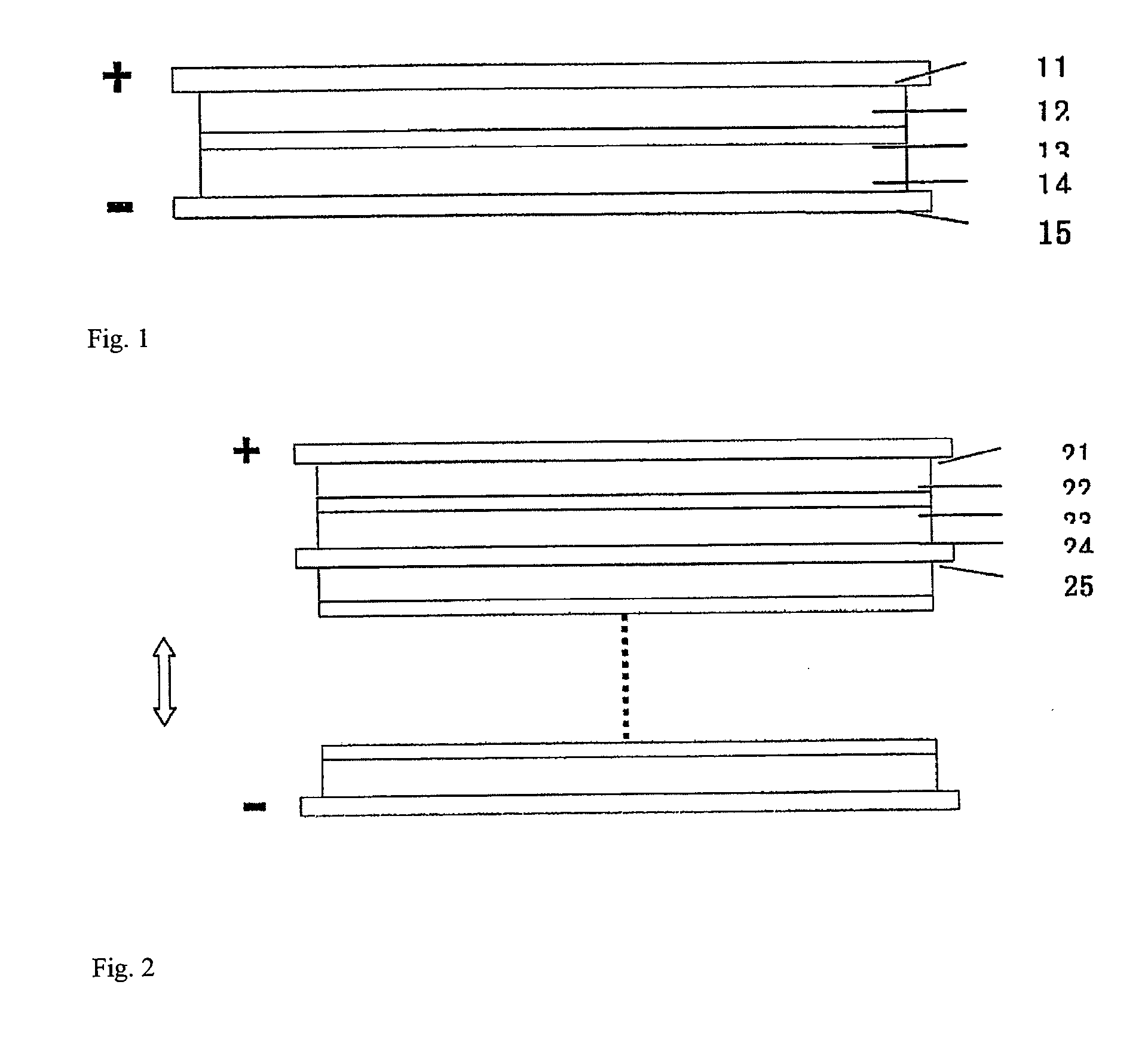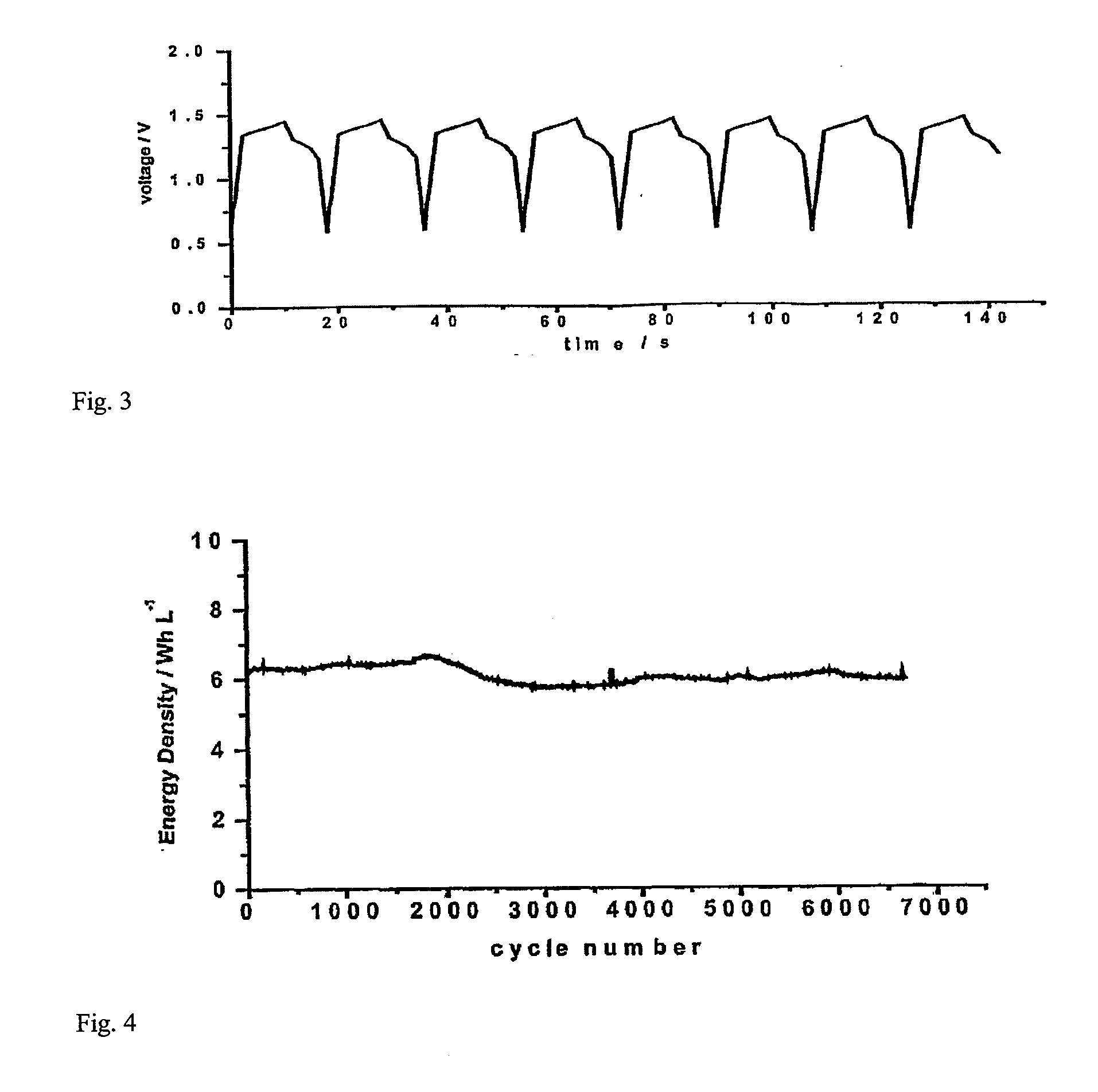Supercapacitor
a supercapacitor and capacitor technology, applied in the direction of multiple hybrid/edl capacitors, reduction-oxidation hybrid capacitors, electrolytic capacitors, etc., can solve the problems of low power density, poor cycle life and safety, and the drawback of fuel automobiles
- Summary
- Abstract
- Description
- Claims
- Application Information
AI Technical Summary
Benefits of technology
Problems solved by technology
Method used
Image
Examples
example 1
[0039]As shown in FIG. 1, the an embodiment of a supercapacitor according to the present invention comprises positive electrode collector 11, positive electrode chamber 12, separator membrane 13, negative electrode chamber 14, and negative electrode collector 15.
[0040]Graphite felt fabric was employed as both positive and negative chamber 12 and 14 of the supercapacitor. Positive and negative electrode chamber 12 and 14 also act as positive and negative electrodes, respectively. The thickness of the graphite felt fabric was 200 μm, the voidage was 90%. The thickness of positive electrode chamber and negative electrode chamber was from about 0.01 mm to 5.0 mm. 2M VOSO4 / (VO2)2SO4+1M H2SO4 was employed as the positive electrode electrolyte, and 2M VOSO4 / V2 (SO4)3+1M H2SO4 was employed as the negative electrode electrolyte. A cation exchange membrane was employed as separator membrane 13, and graphite was employed as positive and negative electrode collector 11 and 15. FIG. 3 shows the ...
example 2
[0042]As shown in FIG. 2, another embodiment of a supercapacitor according to the present invention comprises multiple capacitors in series. In this embodiment, a foam nickel plate was adopted as positive electrode chamber 22 of the supercapacitor, and the activated carbon was employed as negative electrode chamber 24. The thickness of the foam nickel was 2 mm, and the voidage was 90%. The thickness of the activated carbon was 5 mm, and the voidage is 50%. 2M FeSO4 / Fe2(SO4)3+1M H2SO4 was employed as the positive electrode electrolyte, while 2M Ti2(SO4)3 / TiOSO4+1M H2SO4 was employed as the negative electrode electrolyte. An anion exchange membrane was employed as separator membrane 23, and a nickel sheet was used as collector 21 and 25 of positive and negative electrodes, wherein negative electrode collector 25 was a positive and negative dipolar type collector.
example 3
[0043]In this example, the supercapacitor shown in FIG. 1 was employed.
[0044]Carbon fabric was employed as positive and negative electrode chamber 12 and 14 of the supercapacitor. Positive and negative electrode chamber 12 and 14 also act as the positive and negative electrodes. The thickness of the carbon cloth was 1 mm and the voidage was 60%. 2M VOSO4 / (VO2)2SO4+1M Ce(SO4)2 / Ce2(SO4)3+1M H2SO4 was employed as the positive electrode electrolyte and 2M (UO2)2SO4 / UO2SO4+1M H2SO4 was employed as the negative electrode electrolyte. An anion exchange membrane was employed as separator membrane 13, and a stainless steel sheet was employed as collector 11 and 15 of the positive and negative electrodes.
PUM
| Property | Measurement | Unit |
|---|---|---|
| size | aaaaa | aaaaa |
| thickness | aaaaa | aaaaa |
| size | aaaaa | aaaaa |
Abstract
Description
Claims
Application Information
 Login to View More
Login to View More - R&D
- Intellectual Property
- Life Sciences
- Materials
- Tech Scout
- Unparalleled Data Quality
- Higher Quality Content
- 60% Fewer Hallucinations
Browse by: Latest US Patents, China's latest patents, Technical Efficacy Thesaurus, Application Domain, Technology Topic, Popular Technical Reports.
© 2025 PatSnap. All rights reserved.Legal|Privacy policy|Modern Slavery Act Transparency Statement|Sitemap|About US| Contact US: help@patsnap.com



